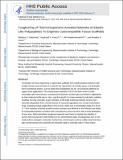Toughening of Thermoresponsive Arrested Networks of Elastin-Like Polypeptides To Engineer Cytocompatible Tissue Scaffolds
Author(s)
Khademhosseini, Ali; Glassman, Matthew James; Avery, Reginald Keith; Olsen, Bradley D
DownloadOlsen_Toughening of.pdf (1.280Mb)
PUBLISHER_POLICY
Publisher Policy
Article is made available in accordance with the publisher's policy and may be subject to US copyright law. Please refer to the publisher's site for terms of use.
Terms of use
Metadata
Show full item recordAbstract
Formulation of tissue engineering or regenerative scaffolds from simple bioactive polymers with tunable structure and mechanics is crucial for the regeneration of complex tissues, and hydrogels from recombinant proteins, such as elastin-like polypeptides (ELPs), are promising platforms to support these applications. The arrested phase separation of ELPs has been shown to yield remarkably stiff, biocontinuous, nanostructured networks, but these gels are limited in applications by their relatively brittle nature. Here, a gel-forming ELP is chain-extended by telechelic oxidative coupling, forming extensible, tough hydrogels. Small angle scattering indicates that the chain-extended polypeptides form a fractal network of nanoscale aggregates over a broad concentration range, accessing moduli ranging from 5 kPa to over 1 MPa over a concentration range of 5–30 wt %. These networks exhibited excellent erosion resistance and allowed for the diffusion and release of encapsulated particles consistent with a bicontinuous, porous structure with a broad distribution of pore sizes. Biofunctionalized, toughened networks were found to maintain the viability of human mesenchymal stem cells (hMSCs) in 2D, demonstrating signs of osteogenesis even in cell media without osteogenic molecules. Furthermore, chondrocytes could be readily mixed into these gels via thermoresponsive assembly and remained viable in extended culture. These studies demonstrate the ability to engineer ELP-based arrested physical networks on the molecular level to form reinforced, cytocompatible hydrogel matrices, supporting the promise of these new materials as candidates for the engineering and regeneration of stiff tissues.
Date issued
2016-01Department
Massachusetts Institute of Technology. Department of Biological Engineering; Massachusetts Institute of Technology. Department of Chemical EngineeringJournal
Biomacromolecules
Publisher
American Chemical Society (ACS)
Citation
Glassman, Matthew J.; Avery, Reginald K.; Khademhosseini, Ali and Olsen, Bradley D. “Toughening of Thermoresponsive Arrested Networks of Elastin-Like Polypeptides To Engineer Cytocompatible Tissue Scaffolds.” Biomacromolecules 17, no. 2 (February 2016): 415–426 © 2016 American Chemical Society
Version: Author's final manuscript
ISSN
1525-7797
1526-4602